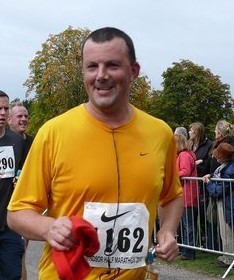Achilles issues during lockdown
Posted on 29th April 2020 at 16:34
In achilles tendon rehabiltation there are 4 key things you can do to address the problem.
1. Correct training error
2. Find a sweet spot for training load and progress from this gradually.
3. Strength and conditioning
4. Address intrinsic factors that may be hindering your rehab
What is training error and how can we address it.
A training error can usually be identified by reviewing training sessions that may have changed the amount of load that the tendon was use to when you were symptom free. Sudden increases of hill or speed sessions can often be related to the achilles tendon becoming overloaded and painful. Changes in footwear where the specifity of the new shoes characteristics like drop ( difference between height of shoe sole at the heel in relation to the height of the shoe sole at the pad of the big toe) or pronation angle ( angle of difference in height between outside and inside of the heel) suddenly change can be factors that overload the tendon. Consistency of training or weekly mileage should also be considered as achilles tendons are more likely to adapt to changes in load where weekly mileage is below 10%.
If you are able to identify a training error returning to previous training sessions that did not provoke tendon pain often can resolve or reduce the problem. This then would allow for a more graduated increase in training load to take place without provoking discomfort.
How to find a sweet spot for training load.
In the majority of cases where achilles tendon pain has presented with no history of significant trauma, reducing training load to a level where the achilles is able to recover and become stronger will result in a reduction or full resolution of symptoms eventually. However this is not likely to happen quickly.
Resting the achilles from all activity may help in the short term however if the achilles tendon is not subject to some form of load there is no stimulus for it to maintain tendon strength hence when training resumes the problem is likely to return.
Finding a training load that does not increase the achilles pain which is being experienced by more than 4/10 on a visual analogue scale (where 10 is the worst pain ever) during exercise and returns to pre-exercise levels within 24 hrs is the sweet spot for training load.
Once the sweet spot is established and it becomes apparent that symptoms are easing at this level, small increases in training load can be made and will result in the achilles tendon adapting and becoming stronger without pain increasing.
Example of finding a sweet spot for training load which allows for tendon adaption and increased tendon strength.
A runner does 3 runs of 8 miles a week (24 miles per week) and develops achilles pain which is not resolving and getting worse. For 2 weeks they reduce their runs to 6 miles but continue to run 3 times per week and find that this level of training load (sweet spot of 18 miles per week) allows their achilles pain to reduce in severity. On the third week they increase training load by less than 10% and do 2x7 mile runs and 1x 5 mile run (19 miles per week) and find their tendon continues to be less painful so their new sweet spot for training load would be 19 miles per week.
Improving strength and conditioning
Improving the strength of muscles that are associated with running gait can assist the calf muscles and achilles tendon in propulsion and improve control of joint motion and efficiency in running or walking. The main muscle groups that contribute to propulsion during these activities are the Gluteals, Hamstrings, Quadriceps and Calf muscles so strengthening exercises like squats, lunges, hip thrusts and dead lifts will be beneficial. These exercises should be done at a level where muscle fatigue or the feeling that the exercise is becoming tough is experienced. Ranges of these exercises can be varied to reduce positions where there is significant achilles pain.
Double and single leg heel raises directly involve the achilles and should also be included in your programme provided that the discomfort that is experienced from the achilles during the exercise stays below a 4/10 and there is no significant change in tendon discomfort over a 24 hour period.
Smaller muscles around the ankle as well as the foot that flex and extend the toes should not be neglected as they help contribute to movement control of the foot during stance and provide a stiff and strong base to assist in pushing the foot off the ground at the end of stance.
Intrinsic factors that can hinder rehabilitation
The biggest issue that we come across when rehabilitating tendons is when clients believe all experiences of pain relate to tissue damage. In the case of tendon pain which has arisen without significant trauma there is usually minimal correlation to the pain you may be experiencing and tissue damage. Having the mindset that your tendon has become sensitive or reactive to load rather than being damaged is more useful and physiologically correct.
Patience and compliance to graduated loading as you rehabilitate your tendon are key. It can take a long time to fully recover from achilles pain however this would seldomly prevent you from doing any training at all.
Knowing and accepting your current limits of training and gradually building them back up again to achieve your set goals can be a rewarding and worthwhile experience.
If you would like further help or information on graduated achilles rehabilitation please feel free to contact us for a consultation.
Author
Craig Fowlie

Craig is a highly specialized physiotherapist with post graduate qualifications in Acupuncture and Sports and Exercise Medicine.
He has worked with Professional Rugby sides in New Zealand and has assisted Great Britain Table Tennis at the World Team Championships and Olympic Qualifiers in Qatar and Germany. He is a consultant for the Governments Talented Athlete Scholarship Scheme and has published and presented research in the Journal of Physiotherapy and the Chartered Society of Physiotherapy Annual Conference.
Outside of work he enjoys participating socially in triathlon and running.
Tagged as: achilles, colchester physiotherapist, lock down, physioreallyhelps, quality assured clinic, rehabilitation, remote consultation
Share this post:







